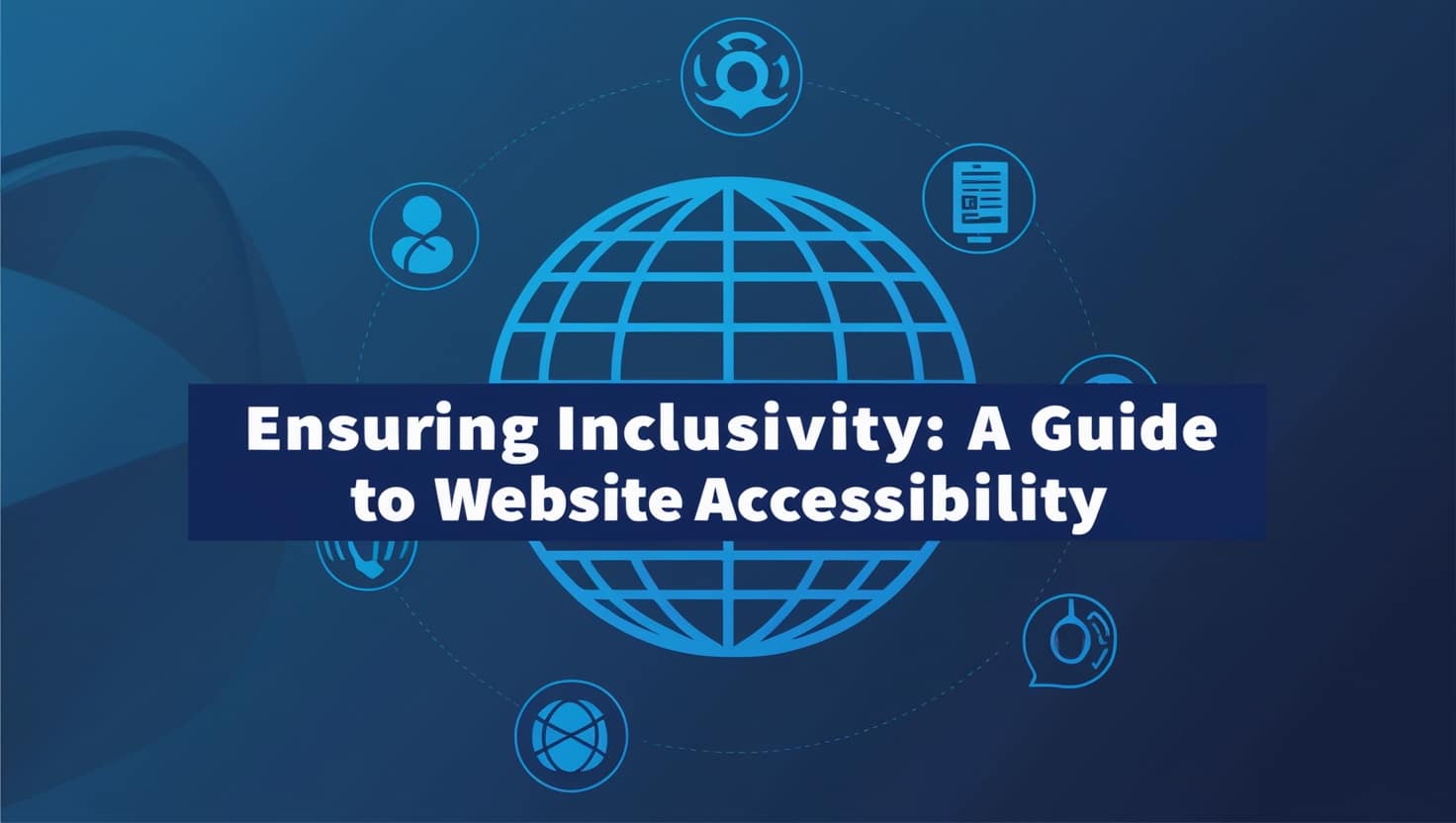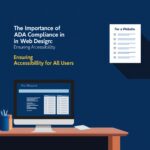Ensuring inclusivity on websites is a crucial aspect of website design that is often overlooked. With the increasing number of people with disabilities accessing the internet, it is essential to ensure that websites are accessible to everyone, regardless of their abilities. The World Wide Web Consortium (W3C) has set guidelines for website accessibility, which website designers and developers can use to ensure that their websites are accessible to everyone.
Website accessibility is not just about providing equal access to people with disabilities; it is also about creating a better user experience for everyone. Websites that are accessible are easier to navigate and use, which means that they are more likely to be used by a wider range of people. Moreover, websites that are accessible are more likely to be ranked higher by search engines, which means that they are more likely to be found by potential customers.
In this article, we will explore the importance of website accessibility and provide a guide to ensuring inclusivity on websites. We will look at the guidelines set by the W3C and provide practical tips for website designers and developers to ensure that their websites are accessible to everyone. We will also look at the benefits of website accessibility and why it is essential to ensure that websites are accessible to everyone.
Understanding Website Accessibility
Website accessibility refers to the practice of designing and developing websites that are inclusive and accessible to everyone, including those with disabilities. It is important to understand the significance of website accessibility and the repercussions of exclusionary design. By ensuring inclusivity, website owners can expand their audience reach and provide equal access to information and services.
There are several guidelines and standards that website owners and developers can follow to ensure accessibility. One such guideline is the Web Content Accessibility Guidelines (WCAG), which is a set of criteria that outlines how to make web content more accessible. WCAG guidelines are divided into three categories: perceivable, operable, and robust. This means that web content should be designed to be perceivable, operable, and robust for all users.
Inclusive design is an important aspect of website accessibility. This means designing websites that are accessible to everyone, including those with disabilities. Inclusive design involves considering the needs of all users, including those with disabilities, and designing websites that are easy to use and navigate.
Assistive technologies such as screen readers, magnifiers, and voice recognition software can help users with disabilities access web content. Website owners and developers should consider these technologies when designing and developing websites.
It is important to note that there are accessibility regulations and standards that website owners and developers must follow. These regulations and standards vary by region and country, but they all aim to ensure that websites are accessible to everyone.
To ensure website accessibility, website owners and developers should consider factors such as alt text, navigation, and colour contrast. Alt text is a description of an image that can be read by screen readers, while navigation refers to the ease with which users can move around a website. Colour contrast refers to the difference between the foreground and background colours on a website, which can affect the visibility of text and images.
In summary, website accessibility is an important aspect of digital accessibility that aims to provide equal access to information and services for everyone, including those with disabilities. By following guidelines and standards such as the WCAG, website owners and developers can ensure that their websites are inclusive and accessible to everyone.
Legal Requirements for Accessibility
Ensuring website accessibility is not only a good practice, but it is also a legal requirement. There are several regulations and laws that require public sector bodies to make their websites accessible to everyone, including people with disabilities.
The Equality Act 2010 is a UK law that aims to protect people from discrimination based on their disability. This act requires public sector bodies to make their websites accessible to people with disabilities. Failure to comply with this act can result in legal action being taken against the public sector body.
In addition to the Equality Act 2010, there are also specific accessibility regulations that apply to public sector websites. The Public Sector Bodies Accessibility Regulations require public sector bodies to make their websites accessible to everyone, including people with disabilities. These regulations are based on the Web Content Accessibility Guidelines (WCAG) 2.2, which outlines the success criteria for accessible websites.
The government digital service (GDS) has also provided guidance on how to create an accessibility statement for public sector websites. This statement should outline how the website meets the accessibility regulations and what steps have been taken to ensure accessibility. The accessibility statement should be easy to find and understand for all users.
It is important to note that there may be circumstances where it is not possible to make a website fully accessible. In these cases, public sector bodies can claim an exemption or a disproportionate burden. However, this should only be done after careful consideration and should be based on evidence.
In summary, making a website accessible is not only a good practice, but it is also a legal requirement for public sector bodies. Failure to comply with accessibility regulations can result in legal action being taken against the public sector body. It is important to follow the WCAG 2.2 success criteria and provide an accessibility statement to ensure that the website meets the legal requirements for accessibility.
Incorporating Inclusivity in Design
When it comes to designing a website, inclusivity is a crucial aspect that should be considered. Incorporating inclusivity in design helps to ensure that everyone, regardless of their abilities, can access and use the website. Inclusive design is a design approach that aims to create products and services that are accessible to everyone, regardless of their abilities. Inclusive design is not just about designing for people with disabilities, but also for people with different needs and preferences.
One of the key aspects of inclusive design is mobile app design. Mobile apps are becoming increasingly popular, and it is essential to ensure that they are accessible to everyone. Inclusive design for mobile apps involves creating user interfaces that are easy to navigate, with clear and concise instructions. The design should also incorporate features such as colour contrast, which makes it easier for people with visual impairments to use the app.
Another critical aspect of inclusive design is user interface design. The user interface should be intuitive and easy to use, with clear and concise instructions. The design should also incorporate features such as high contrast, which makes it easier for people with visual impairments to use the website.
Navigation is another important aspect of inclusive design. Navigation should be easy to use, with clear labels and instructions. The design should also incorporate features such as keyboard navigation, which makes it easier for people with mobility impairments to use the website.
Colour contrast is another critical aspect of inclusive design. The design should incorporate colours that provide adequate contrast, making it easier for people with visual impairments to use the website. The design should also avoid using colours that are difficult to distinguish, such as red and green.
Overall, incorporating inclusivity in design is essential for creating websites that are accessible to everyone. Inclusive design involves creating user interfaces that are easy to navigate, with clear and concise instructions. The design should also incorporate features such as colour contrast, which makes it easier for people with visual impairments to use the website. By incorporating inclusivity in design, websites can be made accessible to everyone, regardless of their abilities.
Accessibility in Different Platforms
Ensuring inclusivity in website accessibility is crucial in today’s digital world. With the increasing use of the internet, it is essential to ensure that websites, mobile apps, social media, intranets, extranets, and archived websites are accessible to all users, including those with disabilities.
Different platforms have different accessibility requirements, and it is important to take these into account when designing and developing websites and applications. For instance, mobile devices have smaller screens, and users may have to zoom in to read content. Therefore, it is crucial to ensure that the content is readable and that users can navigate the website or app with ease.
Social media platforms have their own accessibility guidelines, and it is important to ensure that the content shared on these platforms is accessible to all users. For example, users with visual impairments may use screen readers, and it is essential to ensure that the content is compatible with these tools.
Intranets and extranets are often used within organisations, and it is important to ensure that these platforms are accessible to all employees. This includes employees with disabilities, such as those with visual impairments or hearing loss. It is important to provide alternative formats for content, such as audio or large print, to ensure that all employees can access the information they need.
Archived websites may also need to be made accessible. It is important to ensure that the content is still accessible to users, even if the website was designed before accessibility guidelines were put in place.
In conclusion, ensuring inclusivity in website accessibility is essential in today’s digital world. Different platforms have different accessibility requirements, and it is important to take these into account when designing and developing websites and applications. By ensuring that websites, mobile apps, social media, intranets, extranets, and archived websites are accessible to all users, including those with disabilities, we can create a more inclusive and accessible digital world.
Implementing Accessibility Standards
Web accessibility standards are designed to ensure that websites are accessible to all users, regardless of their abilities. The Web Content Accessibility Guidelines (WCAG) are the most widely recognized standards for web accessibility. These guidelines provide a framework for creating accessible websites and include a set of success criteria that must be met to achieve a certain level of accessibility.
The latest version of the WCAG is 2.2, which includes several new success criteria that are designed to improve the accessibility of websites. These new criteria include requirements for captions and audio descriptions for live video content, as well as improved support for users with cognitive and learning disabilities.
To ensure that a website meets the WCAG 2.2 AA standard, it is important to follow the guidelines closely and implement the necessary accessibility features. This may include providing alternative text for images, ensuring that all content is keyboard accessible, and using appropriate colour contrast.
The Gov.uk Design System provides guidance on how to implement accessibility standards on government websites. This includes guidance on how to create accessible forms, how to use headings and labels correctly, and how to ensure that content is easy to read and understand.
One of the key components of implementing accessibility standards is ensuring that all content on the website is accessible to users with disabilities. This includes providing alternative text for images, ensuring that videos are captioned, and using appropriate markup for tables and other data.
Overall, implementing accessibility standards is an important step in ensuring that websites are inclusive and accessible to all users. By following the WCAG guidelines and implementing the necessary accessibility features, website owners can create a more inclusive online experience for all users.
Assistive Technologies for Accessibility
Assistive technologies are software or hardware tools that help individuals with disabilities access digital content. These technologies can include screen readers, screen magnifiers, braille displays, and more. By using assistive technology, individuals with disabilities can navigate and interact with websites that would otherwise be inaccessible to them.
Screen readers are one of the most commonly used assistive technologies. They are software programs that read aloud the content of a website, allowing individuals with visual impairments to access the information on the page. Screen readers can also interact with the website, allowing users to navigate through links and forms.
Another common assistive technology is the screen magnifier. This tool enlarges the content of a website, making it easier for individuals with low vision to read and interact with the page. Some screen magnifiers also offer colour filters and contrast adjustments to make the content more visible.
Braille displays are another type of assistive technology. These devices translate the content of a website into braille, allowing individuals with visual impairments to read the text through touch. Braille displays can also interact with the website, allowing users to navigate through links and forms.
It is important to ensure that websites are designed with accessibility in mind so that assistive technologies can be used effectively. This includes using appropriate HTML tags, providing alternative text for images, and ensuring that the website is navigable with a keyboard. By designing websites with accessibility in mind, individuals with disabilities can use assistive technologies to access the same content as everyone else.
Role of Organisations and Teams
Ensuring website accessibility is a shared responsibility between organisations and teams. The public sector websites must comply with the accessibility regulations set by the government digital service (GDS). The GDS provides guidelines and resources to help organisations and teams make their websites accessible to everyone.
Public sector organisations must ensure that their procurement policies include accessibility requirements. They must also monitor their websites regularly to ensure compliance with accessibility standards. Community engagement is also essential in ensuring inclusivity. Organisations and teams must engage with disabled users and accessibility experts to understand their needs and improve their websites’ accessibility.
Suppliers of systems and services must also comply with accessibility requirements. Organisations must ensure that their suppliers are aware of the accessibility standards and provide accessible solutions. Accessibility must be considered in all projects, and teams must receive training on accessibility to ensure that they have the necessary skills to create accessible websites.
In conclusion, organisations and teams must work together to ensure inclusivity in website accessibility. The government digital service provides guidelines and resources to help organisations and teams comply with accessibility standards. Procurement policies, monitoring, community engagement, suppliers, systems, accessibility experts, projects, and training are all essential factors in ensuring website accessibility.
Understanding Users with Disabilities
Website accessibility is about ensuring that people with disabilities can use and navigate a website with ease. Understanding the needs and limitations of users with disabilities is crucial to creating an inclusive website.
People with disabilities have a wide range of needs and abilities, and it is important to consider these when designing a website. Some disabilities are visible, such as mobility impairments, while others are invisible, such as learning disabilities.
Users with mobility impairments may have difficulty using a mouse or keyboard, and may rely on assistive technologies such as voice recognition software or screen readers. Websites should be designed to be compatible with these technologies, and should provide alternative ways of navigating the site, such as keyboard shortcuts.
Users with learning disabilities may have difficulty processing information and may benefit from clear and simple language, visual aids, and audio descriptions. Websites should be designed to be easy to navigate, with clear headings and labels, and should avoid complex language and jargon.
It is also important to consider the needs of users with visual impairments. Websites should be designed to be compatible with screen readers, and should provide alternative text for images and other visual elements.
In summary, designing an accessible website requires an understanding of the needs and limitations of users with disabilities. By considering the needs of these users, websites can be designed to be inclusive and accessible to everyone.
Conclusion
Ensuring inclusivity for website accessibility is not only a legal requirement but also a moral obligation. By making a website accessible, businesses can reach a wider audience, including people with disabilities. This can lead to an increase in revenue and customer satisfaction.
Website accessibility is not a one-time task. It requires continuous effort and attention to detail. Testing and monitoring should be done regularly to ensure that the website remains accessible to all users.
Inclusive design is key to ensuring accessibility. This means designing with a diverse audience in mind and considering the different needs of users. Inclusive design can help to remove barriers that prevent people with disabilities from accessing a website.
There are many tools and resources available to help businesses ensure website accessibility. These include accessibility checkers, assistive technologies, and guidelines such as the Web Content Accessibility Guidelines (WCAG). By following these guidelines, businesses can ensure that their website is accessible to all users.
In conclusion, ensuring inclusivity for website accessibility is essential for businesses to reach a wider audience and comply with legal requirements. Inclusive design, regular testing, and the use of tools and resources can help to achieve this goal.







